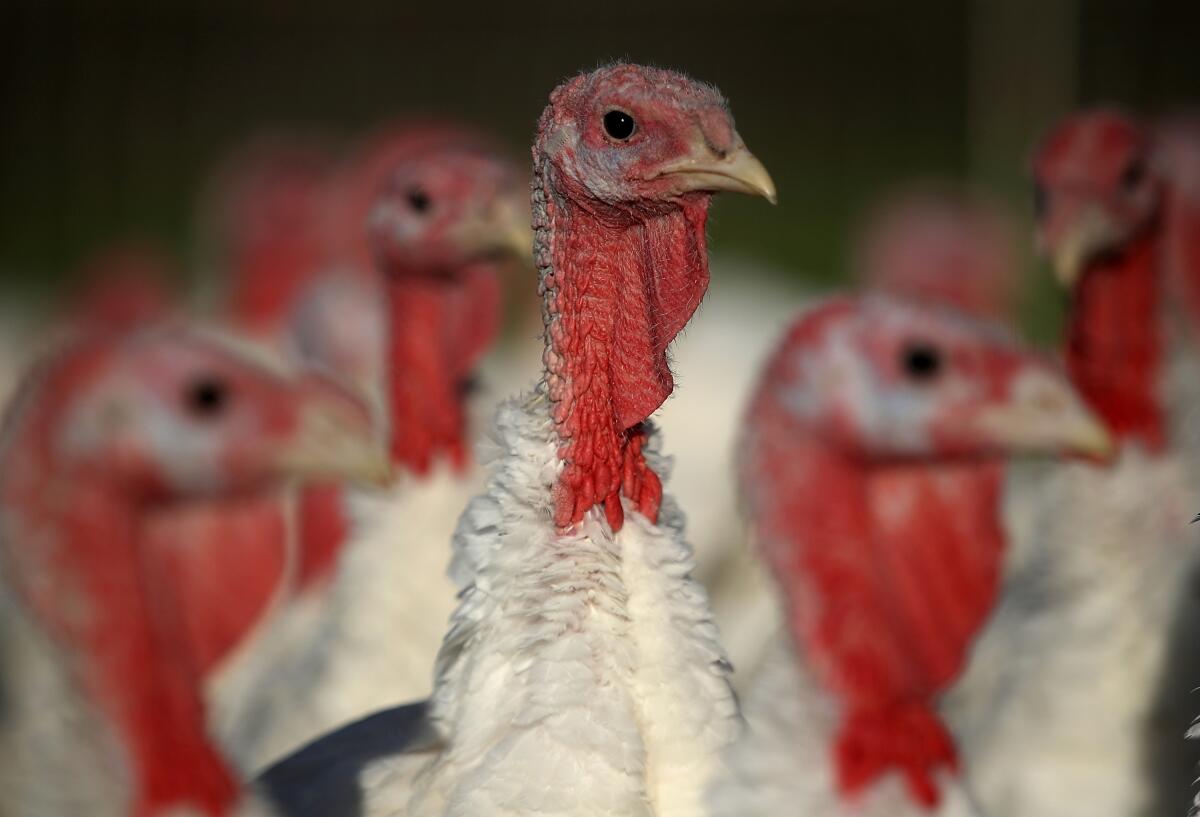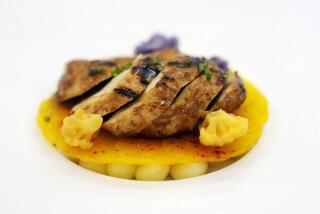Your turkey would be thankful for better treatment before it reaches your plate

- Share via
The turkeys that were booked into suites at the Willard Hotel in Washington before a visit to the White House where President Biden pardoned them from being a Thanksgiving dinner are living fantasy lives. (The birds, Liberty and Bell, will spend the rest of their lives at the University of Minnesota’s College of Food, Agricultural and Natural Resource Sciences in St. Paul.) A few other lucky birds will be adopted by animal welfare advocates at this time of the year.
Rare is the turkey that has anything other than a miserable life before it ends up at a market. Most of the estimated 46 million turkeys that will be sold around Thanksgiving spend their 14 to 20 weeks of life in a sunless barn where they grow unnaturally large, making for crowded conditions with no activity beyond eating and pecking each other — even though many have had their beaks painfully trimmed.
Before slaughter, the birds — flapping and wriggling — are shackled upside down by their legs and dunked in electrified water. That is supposed to leave them unconscious, but sometimes it doesn’t. Then, unconscious or not, they are killed by mechanical throat-cutting blades. These practices have been widely reported.
Approximately 46 million turkeys are slaughtered for Thanksgiving, and this year the suffering of the industrially farmed birds is compounded by the return of avian flu.
Only poultry is treated this gruesomely. Factory-farmed turkeys (and broiler chickens) don’t even have basic government welfare standards over life and death that other food animals do, because poultry is not covered by the Humane Methods of Slaughter Act, which is enforced by the U.S. Department of Agriculture. That seems ridiculous, but so far there has been no political will to change the law, animal welfare advocates say.
However, turkey suppliers and grocery stores can pressure farms to improve these conditions. And we should demand that they do so.
Increasingly, turkey suppliers are switching to what’s called “controlled atmosphere stunning” to kill the birds. The animals are taken in crates out of their barns and go straight to compartments at a slaughterhouse, where they are gradually stunned with gas that puts them to sleep and eventually kills them. They never leave the crates in the process and are not shackled alive. Workers prefer this method as well because they don’t have to handle heavy live birds flapping and resisting.
This article was originally on a blog post platform and may be missing photos, graphics or links.
At least four of the top 10 turkey sellers — Perdue, Tyson, Jenny-O Turkey Store, and Butterball — say they use the controlled-atmosphere stunning procedure.
This is a good start. All turkey suppliers should use gas stunning for all their operations. In addition to that, conditions in barns for turkeys should be overhauled. Birds should have room to roam in the barns and items for enrichment — like perches or bales of hay to peck at — and they should be allowed outside in sunlight.
Consumers who want to buy turkeys that have been humanely raised and slaughtered need to pay attention to welfare labels, which can be confusing. The ASPCA has a guide to labels. But turkey producers and stores use various labels on their products, and some are stricter than others.
Butterball says it follows the American Humane Certified standards. But that certification doesn’t set minimum space allowances indoors or insist on better living conditions for the birds — and it does allow routine and painful beak trimming and toe clipping, according to Hillary Dalton, the senior research manager at the nonprofit animal welfare group Compassion in World Farming.
Dalton suggests people look for stamps of approval from Global Animal Partnership, Certified Humane, and Animal Welfare Approved.
Also look for turkeys from small farms that have raised the turkeys outside on pasture. However, few of those farms can afford access to the gas stunning process. Those farms often stun their animals with an electrified knife and then cut their throats. It’s a trade-off: Would you prefer to buy a turkey that lived a more natural life on a farm or a turkey that lived on a grim factory farm but had an easier death?
Of course, we could eat less turkey, which would reduce the demand for these animals. If American consumers are going to eat turkey on Thanksgiving and other days, the least we can do is insist on better conditions for those birds. The fact that millions of turkeys are raised to be food does not mean they should be subjected to inhumane conditions before they end up on our tables.
More to Read
A cure for the common opinion
Get thought-provoking perspectives with our weekly newsletter.
You may occasionally receive promotional content from the Los Angeles Times.










